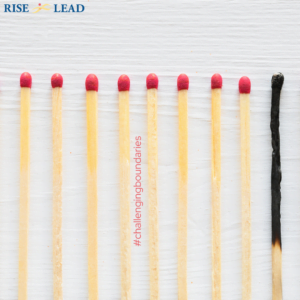
Dear Readers, Dear Leaders,
With a permanent push to over-achieving, over-performing, over-working fueled by both the perception that pushing our limits in unprecedented ways and overdoing will not only guarantee us success and visibility, but might also protect us from either losing our job or being furloughed in the midst of this pandemic, we feel it is to safe to say that burnout has clearly become the second evil of this pandemic.

Searches online for symptoms with terms such as ‘signs of burnout’ have increased by 24%
throughout 2020 compared to the previous year.
People are on the verge, and they need support from their Leadership.
Pressure at work is usually the main factor and when budgets are tight, teams are small and we are in the midst of a global crisis feeding uncertainty then people often find themselves with multiple roles and heavy workloads, piling on the stress.
However, burnout can also result from different factors including :
- Lack of control (inability to influence decisions that affect your job)
- Unclear job expectations (what degree of authority do you have, or what is your management expecting from you)
- Dysfunctional workplace dynamics
- Extremes of activity
- Lack of social support
- Work-life imbalance
For long, we have assumed that burnout would just show up as exhaustion. We today know that burnout shows up in many different forms.
In 2019, the World Health Organisation defined burnout as :
- a state of emotional, physical and mental exhaustion
- increased mental distance from one’s job, or feelings of negativism or cynicism related to one’s job; and
- reduced professional efficacy.
While burnout per se is not a medical condition, its consequences on both our mental & physical health are immense.
Now naively some might say, how can burnout increase, when people have actually been mostly working from home.
Well to start with, independently from the pandemic, people working from home have to fight the strong belief that working from home is less effective.
Just 2 years ago, 46% of UK employees felt the need to combat a perception that working from home is less productive than being in the office, according to LogMeIn. While 36% of workers admitted to suffering from pressure to appear ‘more responsive’ on email while working remotely, 23% also felt pressure to work more hours.
Secondly, the transition to fully working from home has been abrupt. There was not transition, and any adaptive change requires adjustment times and most importantly new learning.
Thirdly, the pandemic and these ongoing lockdowns have exacerbated all human feelings, making life itself difficult to manage.
As Leaders, it is our role to support our people in order to avoid that they reach burnout.
How can you effectively do that :
- communicate regularly and clearly to your teams (set dates in the calendars)
- share the WHY, the WHAT, the HOW
- set clear expectations (do not make any assumptions)
- be clear in terms of timelines – not everything is urgent, otherwise, it means nothing is
- demonstrate compassion
- put Growth (business & human) at the centre
These stigmas that promote burnout are related to leadership cultures that need to be revisited, as they are fed by management through fear and power. Strong leadership is not about that.
Strong leadership is about “LEADING by the POWER of YOUR EXAMPLE”.





